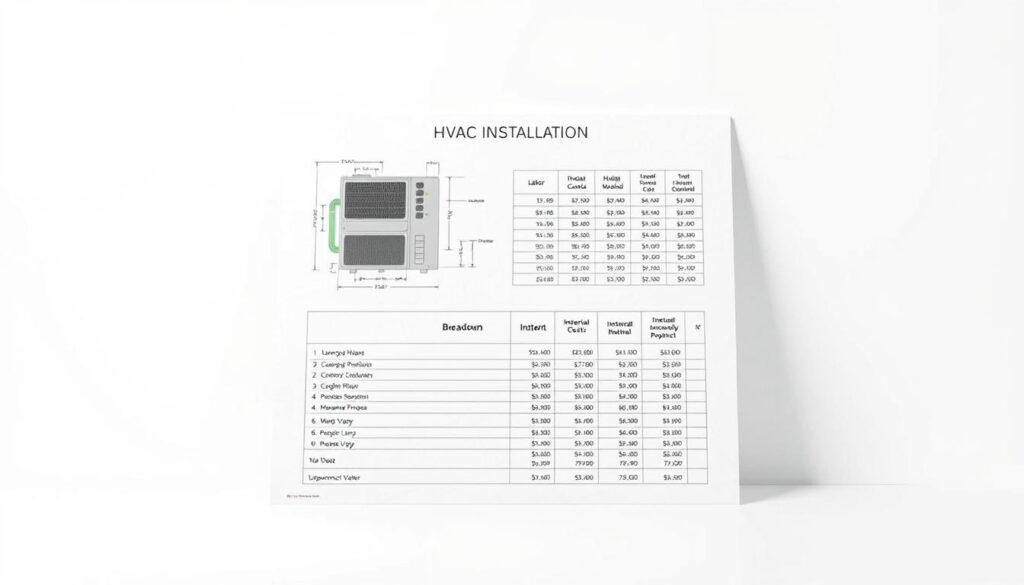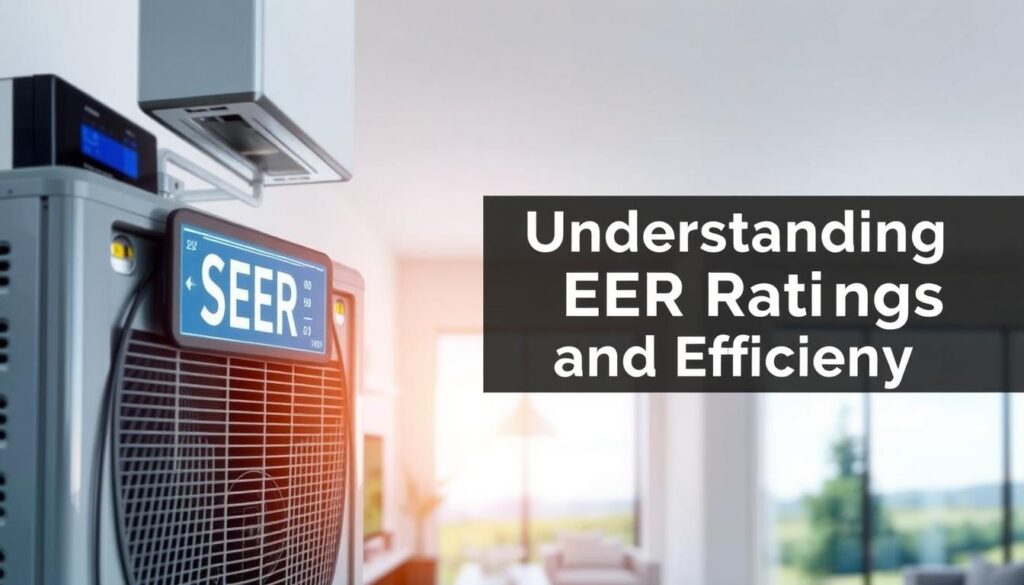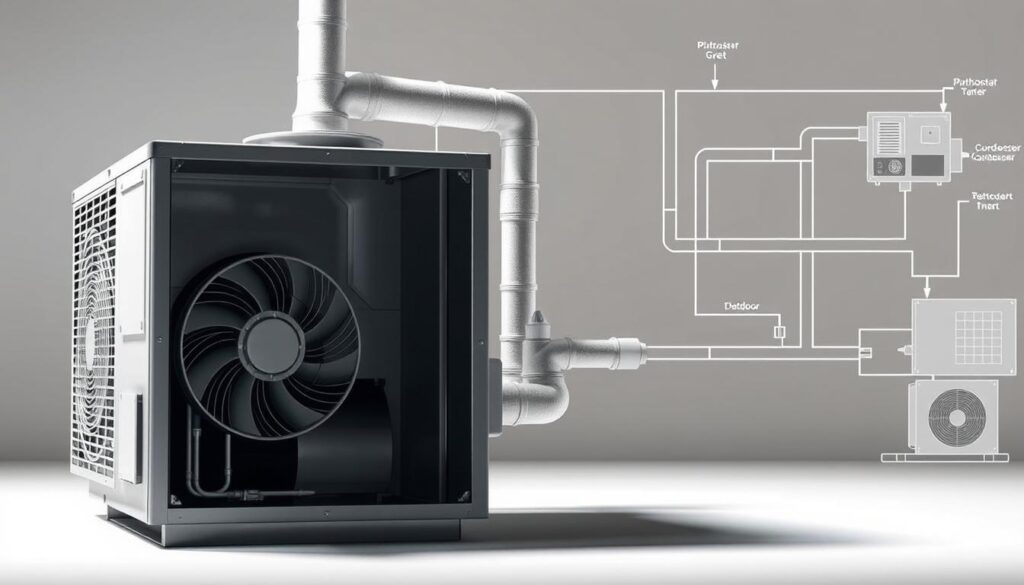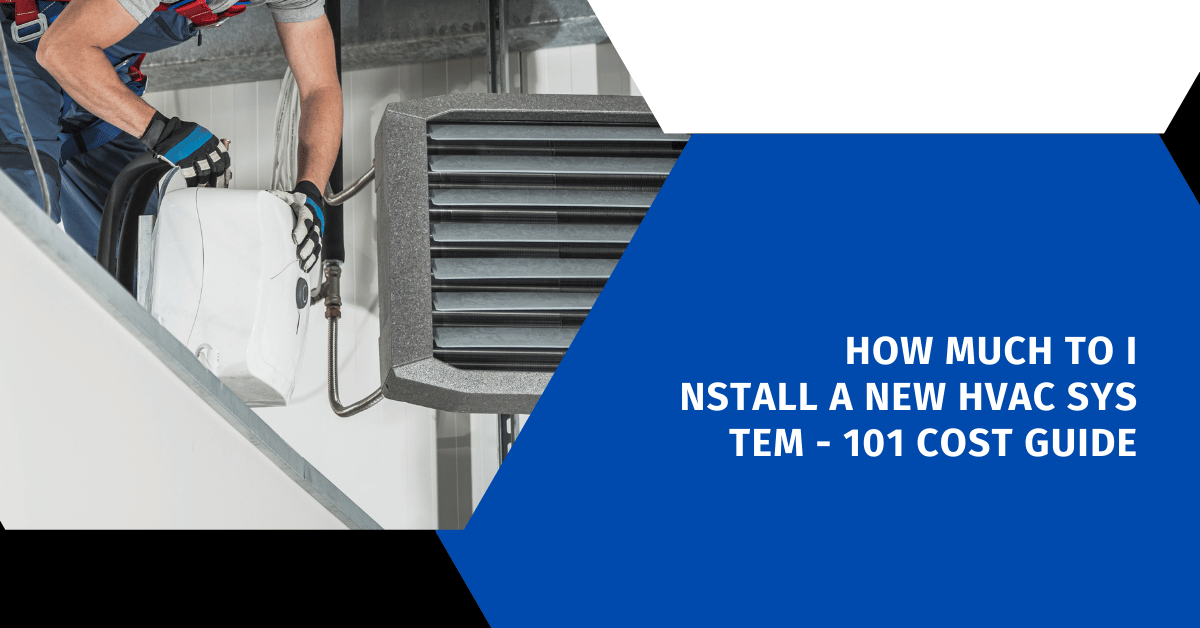Affiliate Disclosure
HVAC Guide Guys is a participant in the Amazon Services LLC Associates Program, an affiliate advertising program designed to provide a means for sites to earn advertising fees by advertising and linking to Amazon.
How Much to Install a New HVAC System? Learning about HVAC installation costs can save you a lot of money. This guide will help you understand the costs of replacing your HVAC system. You’ll be able to make smart choices that fit your budget.

Are you curious about the cost of a new HVAC system for your home? Replacing your HVAC can be a big financial step. The average cost for a new system in homes is between $5,500 and $16,000.
Maybe your system is old or you want to save on energy. Either way, installing a new HVAC system needs careful planning. We’ll cover all the important details that affect the cost. This way, you’ll know exactly what to expect.
Key Takeaways
- HVAC system replacement costs vary widely based on home size and system complexity
- Energy efficiency can significantly impact long-term financial savings
- Professional installation is key for the best system performance
- Many factors affect the total cost of installation
- Planning ahead can help manage your HVAC investment costs
Table of Contents
Understanding HVAC System Installation Basics
Choosing the right heating and cooling system is key for comfort and efficiency at home. Modern HVAC systems come in various types to fit different needs. Each has its own features and prices for central air conditioning installation.
When picking a new HVAC system, several factors matter for comfort and energy use. Knowing the basics helps you choose the best for your home’s temperature control.
Types of HVAC Systems
- Central Air Conditioning Systems
- Heat Pump Systems
- Ductless Mini-Split Systems
- Packaged HVAC Units
Performance Levels of Air Conditioning Systems
| System Type | Efficiency | Price Range |
|---|---|---|
| Single-Stage | Low | $2,500 – $4,000 |
| Two-Stage | Medium | $3,500 – $5,500 |
| Variable-Speed | High | $4,500 – $7,500 |
Key System Components
A full heating and cooling system includes:
- Outdoor Condensing Unit
- Indoor Air Handler
- Ductwork
- Thermostat
- Refrigerant Lines
The cost of central air conditioning installation varies. It depends on the system’s complexity, your home’s size, and local needs. A professional can help you find the best HVAC solution for your home.
Average HVAC Installation Cost Ranges
When you’re planning to install a new HVAC unit, knowing the costs is key. The price can change a lot based on several important factors. Most installations cost between $5,500 and $16,000, with different levels to choose from.
The cost of your new HVAC unit usually falls into three main areas:
- Entry-Level Systems: $5,500 – $8,800
- Basic functionality
- Standard efficiency ratings
- Suitable for smaller homes
- Mid-Range Systems: $6,700 – $9,400
- Better performance
- Improved energy efficiency
- Ideal for medium-sized homes
- High-End Systems: $8,300 – $16,000
- Premium features
- Top-tier energy efficiency
- Advanced technology
Remember, the cost of installing a new HVAC unit isn’t just about the price of the unit. The cost also depends on professional installation, the size of your home, existing ductwork, and your local climate. Always get quotes from certified HVAC pros to make the best choice for your home.
Explore Our HVAC Shop
Looking for top-rated HVAC tools, parts, and accessories? Visit our shop and find the perfect solution for your needs.
Visit the ShopFactors That Impact HVAC Installation Costs
When planning to upgrade your home’s HVAC, knowing what affects costs is key. Several factors come together to shape the price of a new heating and cooling system.
Important elements influence your HVAC quotes and overall project costs:
- Home size and square footage
- Existing home layout and infrastructure
- System efficiency ratings
- Regional climate conditions
- Ductwork requirements
Home Size and Layout Considerations
Your home’s size and layout are critical in choosing an HVAC system. Bigger homes need stronger systems, which raises costs. Unique features like multi-level designs or complex floor plans can also impact costs.
System Efficiency Ratings
Energy efficiency affects both the initial cost and long-term savings. Higher SEER ratings mean a bigger upfront cost but lower running costs. Modern, efficient systems can save a lot of energy over time.
Regional Climate Requirements
Your local climate determines the HVAC system you need. Areas with extreme weather need stronger systems, which can increase costs. Contractors will suggest the best equipment for your area’s climate.
Choosing the right HVAC system can save you money in the long run and make your home more comfortable.
How Much to Install a New HVAC System: Complete Breakdown
Thinking about getting a new HVAC system? It’s a big deal. The cost can range from $5,500 to $16,000. This depends on a few key things.
Several factors affect the total cost:
- Equipment quality and type
- Home square footage
- System efficiency ratings
- Regional climate requirements
- Labor and installation complexity
Let’s dive into the costs you might face:
| System Type | Average Cost Range | Installation Complexity |
|---|---|---|
| Split System | $5,500 – $9,000 | Moderate |
| Ductless System | $6,000 – $12,500 | Higher |
| Heat Pump System | $7,500 – $16,000 | Complex |
Pro tip: Always get multiple quotes from certified HVAC professionals to ensure you’re getting the best value for your hvac replacement cost.
Choosing a high-efficiency system might cost more upfront. But, it can save you money in the long run. Your exact costs will depend on your home and local prices.
Explore Our HVAC Shop
Looking for top-rated HVAC tools, parts, and accessories? Visit our shop and find the perfect solution for your needs.
Visit the ShopEssential Components and Their Costs
When you’re thinking about a new HVAC system, knowing the costs of key parts is important. This helps you plan your budget for central air conditioning. Your total cost will depend on several main parts that work together to keep your home comfortable.
The main parts of a new HVAC system usually are:
- Outdoor condensing unit
- Indoor air handler or evaporator coil
- Thermostat
- Copper refrigerant line set
- PVC drainage pipes
Each part is vital for your system’s performance. The outdoor unit, often the priciest, can cost between $1,500 and $4,000. This depends on its size and how well it works. The indoor coil, which handles heat exchange, might cost between $800 and $2,000.
The thermostat is also key but costs less. Smart thermostats can cost from $100 to $500. They offer better temperature control and help save energy. Copper and PVC pipes are cheaper, costing between $200 and $500 for installation.
Pro tip: Investing in high-quality components can significantly improve your HVAC system’s long-term efficiency and performance.
While the cost of each part is important, how well they work together is what matters most. This affects your home’s comfort and how much energy it uses.
Understanding SEER Ratings and Efficiency
When planning your home HVAC upgrade, knowing about SEER ratings is key. SEER (Seasonal Energy Efficiency Ratio) shows how well your air conditioner cools. It affects your HVAC system cost and energy savings over time.

New standards bring SEER2 ratings, giving a better look at energy use. These ratings help you see the real value of your heating and cooling choices.
SEER2 Rating Requirements
SEER2 ratings vary by region. For example, in the Midwest, AC units need a minimum of 13.4. Higher ratings mean:
- More energy efficiency
- Lower bills
- Less environmental harm
- Better home comfort
Energy Efficiency Benefits
Choosing a high-efficiency HVAC system cuts down energy use. A system with a higher SEER2 rating might cost more at first but saves money later on energy bills.
Cost vs. Performance Analysis
When looking at HVAC upgrade costs, think about the long-term savings. A more efficient system might cost more at first. But, it can save a lot of money over its life.
Higher efficiency means lower energy bills and reduced environmental footprint.
Understanding SEER ratings helps you make a wise choice. It balances performance, comfort, and cost for your home’s needs.
Required Electrical and Ductwork Modifications
Installing a new heating and cooling system can change your home’s electrical and ductwork needs. Your home might need special upgrades for a modern HVAC system.
Electrical work is key for your system’s safety and efficiency. You might need:
- Upgrading electrical panel capacity
- Installing dedicated circuits
- Updating wiring to match system requirements
- Adding circuit breakers
Ductwork changes are also important for better airflow and system performance. These can be small tweaks or big redesigns.
| Modification Type | Estimated Cost Range | Complexity |
|---|---|---|
| Electrical Panel Upgrade | $500 – $2,000 | High |
| New Electrical Circuits | $100 – $600 | Medium |
| Ductwork Modification | $300 – $1,500 | Varies |
Getting a pro’s opinion is important for your HVAC needs. An HVAC technician can check your home’s electrical and ductwork. They’ll give you a clear cost for any needed changes.
Pro tip: Always budget for possible electrical and ductwork upgrades when planning your HVAC installation costs. This way, you won’t face unexpected expenses.
Explore Our HVAC Shop
Looking for top-rated HVAC tools, parts, and accessories? Visit our shop and find the perfect solution for your needs.
Visit the ShopAdditional Installation Considerations
When planning to replace your HVAC system, think about more than just the equipment. Several important factors can affect your project’s success and how well it works over time.
Getting quotes for HVAC systems means understanding the behind-the-scenes needs for a smooth and legal installation.
Permits and Inspections
Most places need special permits for HVAC installations. These documents are key:
- They check if the installation is safe
- Make sure it follows building codes
- Confirm the quality of the work
- Help avoid legal issues later
“Proper permitting protects homeowners and guarantees professional installation standards.”
Warranty Coverage
It’s important to know about warranties when getting quotes for HVAC systems. Different makers offer different coverage:
- Warranties for the equipment
- Guarantees for the installer’s work
- Extended protection plans
- Coverage for parts and labor
Maintenance Requirements
Your new HVAC system needs regular care to stay efficient and keep the warranty valid. Common maintenance tasks include:
- Annual checks by a pro
- Changing filters regularly
- Cleaning the air ducts
- Checking the refrigerant
Regular maintenance can greatly lower the cost of future HVAC replacements and make your system last longer.
HVAC System Size and Capacity Selection

Choosing the right size for your home’s HVAC system is key. It ensures optimal performance and keeps costs down. A system that’s too big or too small can lead to high costs and less comfort.
The Manual J Load Calculation is the way to size your HVAC correctly. It looks at several factors that affect your home’s heating and cooling needs:
- Total square footage of living space
- Number and size of windows
- Ceiling height
- Insulation quality
- Sun exposure
- Number of occupants
“Bigger isn’t always better when it comes to HVAC systems. The right size means maximum efficiency and comfort.” – HVAC Professional
Systems that are too small can’t keep your home at a comfortable temperature. They run all the time, which raises your energy bills. On the other hand, systems that are too big turn on and off too much. This causes uneven cooling and wears out the system faster.
When you talk to HVAC experts, ask for a detailed Manual J Load Calculation. This ensures you get a system that fits your home perfectly. It will work better and save you money in the long run.
Installation Timeline and Process Steps
Planning a residential HVAC installation takes a lot of time and effort. Your heating and cooling system installation is a detailed process. It usually takes several days to ensure it works well and efficiently.
The installation timeline has key stages:
- Initial Assessment and Planning (1-2 days)
- Home evaluation
- System capacity calculation
- Precise measurements
- Equipment Preparation (1 day)
- Selecting appropriate HVAC components
- Scheduling delivery
- Preparing installation site
- Old System Removal (Half-day to 1 day)
- Disconnecting existing equipment
- Safely removing outdated components
- Preparing infrastructure
- New System Installation (1-2 days)
- Installing primary HVAC units
- Connecting electrical systems
- Implementing ductwork modifications
- System Testing and Calibration (Half-day)
- Performance diagnostics
- Efficiency verification
- Final system adjustments
Professional technicians usually finish a standard residential HVAC installation in 2-4 days. Your specific timeline might vary. This depends on your home’s complexity, the system type, and any needed infrastructure changes.
Pro Tip: Always confirm detailed timelines and expectations with your chosen HVAC installation professional before beginning the project.
Explore Our HVAC Shop
Looking for top-rated HVAC tools, parts, and accessories? Visit our shop and find the perfect solution for your needs.
Visit the ShopTax Credits and Rebate Opportunities
There are ways to lower the cost of a new HVAC system. Homeowners can save money through tax credits and rebates. These programs help make the investment more affordable.
Getting a new energy-efficient HVAC system can save you money. These programs encourage homeowners to choose better heating and cooling options.
Federal Tax Incentives
The federal government offers tax credits for energy-efficient HVAC systems. These credits can help you cover some of the costs:
- Up to 30% tax credit for qualifying energy-efficient systems
- Maximum credit of $2,000 for heat pump installations
- Credits available for systems meeting specific energy efficiency standards
State and local Rebates
States also offer financial help for HVAC upgrades. Each state has its own incentives based on energy goals.
| State | Typical Rebate Range | Eligibility Criteria |
|---|---|---|
| California | $500 – $1,500 | Energy Star certified systems |
| New York | $400 – $1,000 | High-efficiency heat pump |
| Texas | $300 – $800 | SEER rating above 16 |
Utility Company Programs
Utility providers also offer rebates for energy-efficient HVAC systems. These programs can save you money right away and in the long run.
- Check with local utility providers for specific rebate programs
- Some utilities offer instant rebates at point of purchase
- Potential for additional energy bill credits
Looking into tax credits and rebates can make installing a new HVAC system easier. It also helps make your home more energy-efficient.
Conclusion
Thinking about installing a new HVAC system? Costs can vary from $5,500 to $16,000. The price depends on your home’s size, the system’s efficiency, and local rules.
Choosing a top-notch HVAC system is more than just the initial cost. It’s about long-term savings, comfort, and energy efficiency. By looking at your home’s needs and talking to experts, you can find a good balance.
Your HVAC system is a big investment in your home. Do your homework, compare different systems, and look for high efficiency. Proper sizing and professional installation are essential for a long-lasting system.
Planning carefully can simplify the HVAC replacement process. Look into tax credits, rebates, and energy-saving tech to cut costs. With the right steps, you’ll enjoy a cozy, efficient home for many years.

